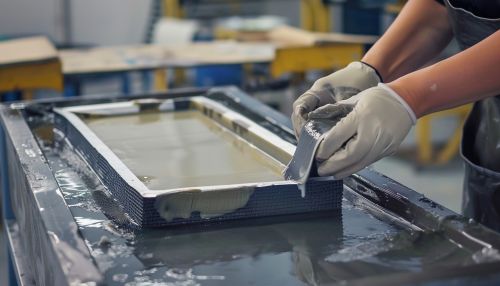Hand Lay-up Process
Introduction
The hand lay-up process is a method used in the manufacturing of composite materials. It is a simple technique that involves the manual placement of reinforcement in a mold and the subsequent application of the resin with the use of a brush or roller. The process is widely used in the production of large composite structures such as boats, tanks, and architectural components due to its low cost and simplicity.
Process Overview
The hand lay-up process begins with the preparation of the mold. The mold is first cleaned and then coated with a release agent to facilitate the removal of the part after curing. The reinforcement, typically a fiberglass mat or fabric, is then manually placed into the mold. The resin, usually a polyester, vinyl ester, or epoxy, is then applied onto the reinforcement. The resin impregnates the reinforcement through manual rolling, brushing, or spraying.


Reinforcement Materials
In the hand lay-up process, the reinforcement material is typically a woven fabric or mat made from glass fibers. However, other materials such as carbon, aramid, or natural fibers can also be used depending on the requirements of the final product. The reinforcement material provides the composite with its mechanical properties, including strength and stiffness.
Resin Materials
The resin in the hand lay-up process serves as the matrix that binds the reinforcement fibers together. The most commonly used resins in this process are polyester, vinyl ester, and epoxy. These resins are chosen for their good mechanical properties, ease of handling, and cost-effectiveness. The resin also provides the composite with its environmental resistance, such as resistance to water, chemicals, and UV radiation.
Curing Process
After the resin is applied, the composite needs to cure. Curing is the process where the resin hardens and takes the shape of the mold. This can be done at room temperature or at elevated temperatures depending on the type of resin used. The curing process can take several hours to days. After curing, the part is removed from the mold and any necessary finishing operations are performed.
Advantages and Disadvantages
The hand lay-up process has several advantages. It is a simple process that does not require expensive equipment or high levels of skill. It is also highly versatile, allowing for the production of parts of virtually any size and shape. However, the process also has its disadvantages. It is labor-intensive and can be slow, especially for large parts. The quality of the parts can also vary depending on the skill of the operator.
Applications
The hand lay-up process is used in a wide range of industries. It is commonly used in the marine industry for the production of boats and other watercraft. It is also used in the construction industry for the production of architectural components such as panels and domes. Other industries that use the hand lay-up process include the automotive, aerospace, and sports equipment industries.
